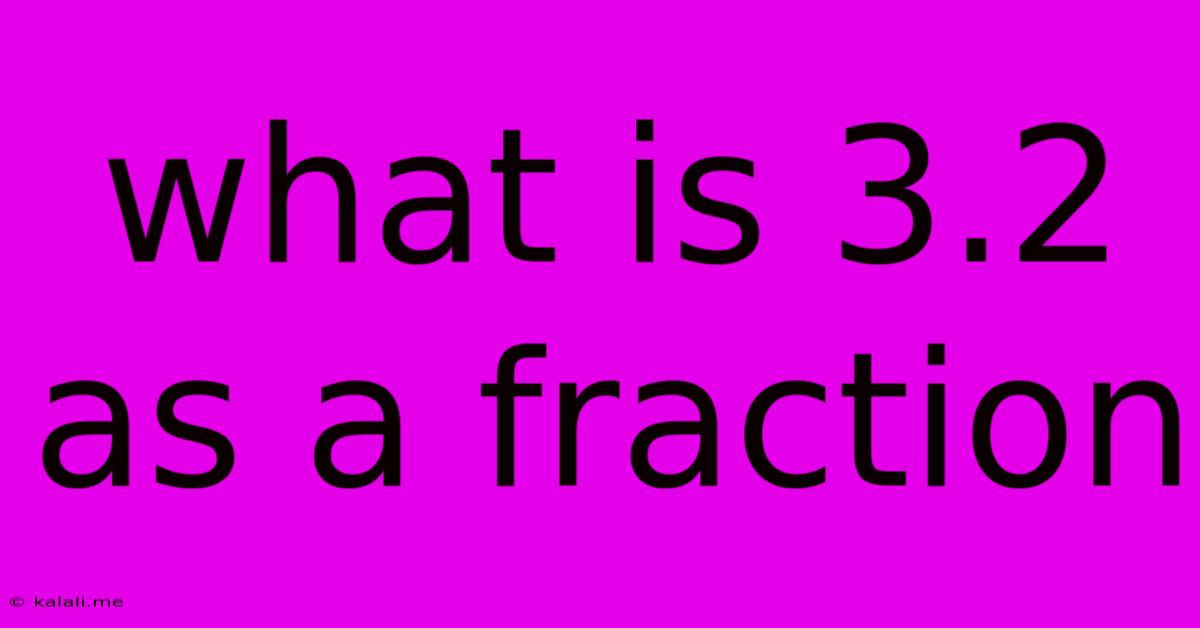What Is 3.2 As A Fraction
Kalali
Apr 13, 2025 · 4 min read

Table of Contents
What is 3.2 as a Fraction? A Comprehensive Guide
Understanding how to convert decimals to fractions is a fundamental skill in mathematics, crucial for various applications from basic arithmetic to advanced calculus. This comprehensive guide will delve into the process of converting the decimal 3.2 into a fraction, explaining the underlying principles and offering practical examples to solidify your understanding. We'll also explore related concepts and offer tips for tackling similar decimal-to-fraction conversions.
Meta Description: Learn how to convert the decimal 3.2 into a fraction. This comprehensive guide explains the process step-by-step, covering the underlying principles and offering practical examples for various decimal-fraction conversions.
The decimal number 3.2 represents three whole units and two tenths. To convert this to a fraction, we need to express this in terms of a numerator (the top number) and a denominator (the bottom number). The process involves understanding place values and simplifying the resulting fraction.
Understanding Place Values in Decimals
Before we begin the conversion, let's review decimal place values. The number 3.2 can be broken down as follows:
- 3: This represents three whole units, or 3/1.
- .2: This represents two tenths, or 2/10.
Therefore, 3.2 is essentially the sum of 3 and 0.2.
Converting 3.2 to a Fraction: Step-by-Step Process
-
Identify the Decimal Part: The decimal part of 3.2 is 0.2.
-
Express the Decimal Part as a Fraction: The digit 2 is in the tenths place, meaning it represents two tenths. This can be written as the fraction 2/10.
-
Combine the Whole Number and Fractional Parts: We now have the whole number 3 and the fraction 2/10. To combine them, we need to find a common denominator. Since 3 can be expressed as 3/1, we need to find an equivalent fraction for 3 with a denominator of 10. This is simply 30/10.
-
Add the Fractions: Now we add the two fractions together: 30/10 + 2/10 = 32/10.
-
Simplify the Fraction: The fraction 32/10 can be simplified by finding the greatest common divisor (GCD) of 32 and 10. The GCD of 32 and 10 is 2. We divide both the numerator and denominator by 2: 32/2 = 16 and 10/2 = 5.
-
Final Result: Therefore, 3.2 as a fraction is 16/5.
Alternative Method: Using Powers of 10
Another approach to converting decimals to fractions involves using powers of 10. This method is particularly useful for decimals with more than one digit after the decimal point.
-
Write the Decimal as a Fraction with a Power of 10 as the Denominator: Since there is one digit after the decimal point in 3.2, we use 10 as the denominator. The number 3.2 becomes 32/10.
-
Simplify the Fraction: As before, we simplify the fraction 32/10 by finding the GCD (2) and dividing both the numerator and the denominator by it, resulting in 16/5.
Converting other decimals to fractions
Let's practice with a few more examples to solidify your understanding:
-
Example 1: Converting 0.75 to a fraction:
- 0.75 means 75 hundredths, which can be written as 75/100.
- The GCD of 75 and 100 is 25.
- Simplifying the fraction: 75/25 = 3 and 100/25 = 4.
- Therefore, 0.75 as a fraction is 3/4.
-
Example 2: Converting 2.375 to a fraction:
- 2.375 can be written as 2375/1000.
- The GCD of 2375 and 1000 is 125.
- Simplifying: 2375/125 = 19 and 1000/125 = 8.
- Therefore, 2.375 as a fraction is 19/8.
-
Example 3: Converting 0.125 to a fraction:
- 0.125 can be written as 125/1000.
- The GCD of 125 and 1000 is 125.
- Simplifying: 125/125 = 1 and 1000/125 = 8.
- Therefore, 0.125 as a fraction is 1/8.
Dealing with Repeating Decimals
Converting repeating decimals (like 0.333...) to fractions requires a slightly different approach involving algebraic manipulation. This is a more advanced topic and is beyond the scope of this specific guide focusing on terminating decimals like 3.2. However, understanding the fundamental principles outlined above provides a solid foundation for tackling these more complex conversions in the future.
Practical Applications
Understanding decimal-to-fraction conversion is invaluable in various real-world scenarios:
-
Baking and Cooking: Recipes often require precise measurements, and converting decimal measurements to fractions ensures accuracy.
-
Construction and Engineering: Accurate measurements are critical in construction and engineering, and fractions are often used in blueprints and calculations.
-
Finance: Calculating interest rates, percentages, and proportions frequently involves working with both decimals and fractions.
-
Science: Many scientific calculations require precise measurements and conversions between decimals and fractions.
Conclusion
Converting decimals to fractions is a fundamental mathematical skill with broad applications. The process, while seemingly simple, requires a solid grasp of place values, greatest common divisors, and the ability to manipulate fractions effectively. By mastering this skill, you'll enhance your overall mathematical proficiency and open doors to more advanced mathematical concepts. Remember to always simplify your fraction to its lowest terms for the most concise and accurate representation. Practice with various examples to build confidence and fluency in decimal-to-fraction conversions. This guide provides a comprehensive starting point, equipping you with the tools and knowledge necessary to tackle a wide range of decimal-fraction conversions successfully.
Latest Posts
Latest Posts
-
How Do You Pass Level 12 On Bloxorz
Jul 12, 2025
-
How Far Is 0 4 Miles To Walk
Jul 12, 2025
-
What Is 20 Percent Of 800 000
Jul 12, 2025
-
Words That Start With Y In Science
Jul 12, 2025
-
Prevent An Expressway Emergency By Merging Without
Jul 12, 2025
Related Post
Thank you for visiting our website which covers about What Is 3.2 As A Fraction . We hope the information provided has been useful to you. Feel free to contact us if you have any questions or need further assistance. See you next time and don't miss to bookmark.